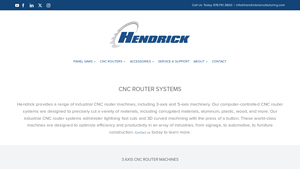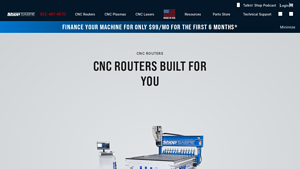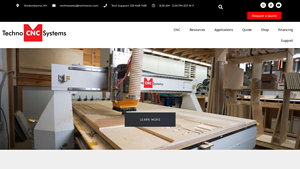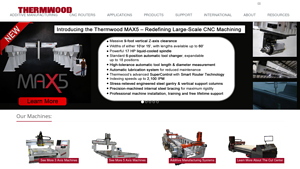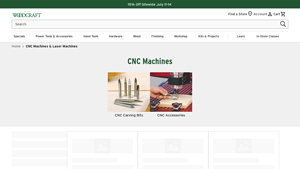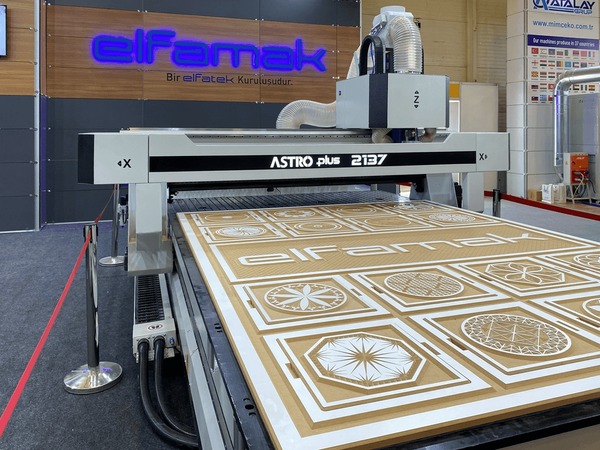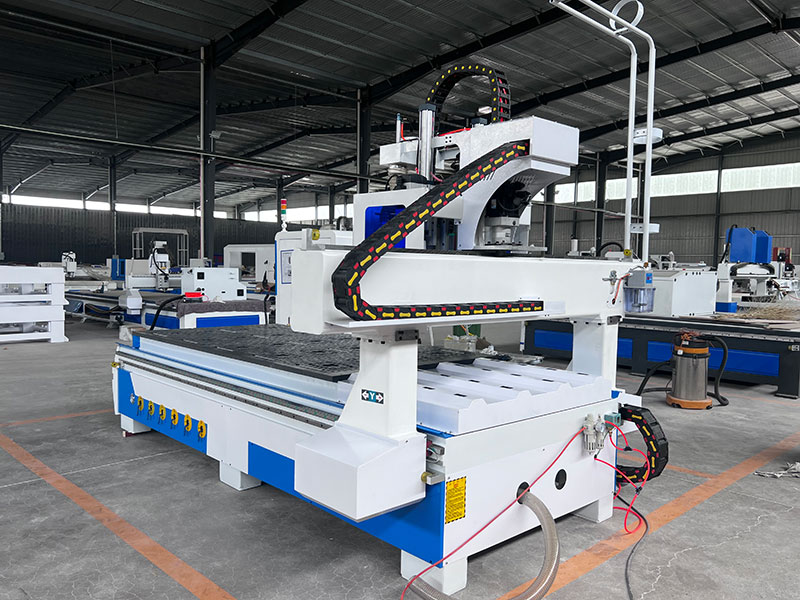Top 7 Cnc Wood Router Manufacturer List and Guide
Top 7 Cnc Wood Router Manufacturer Manufacturers & Suppliers List
1. ShopBot Tools – PRS5 Alpha
Domain: shopbottools.com
Registered: 1996 (29 years)
Introduction: Top CNC Router Manufacturer | ShopBot Tools | Made in USA. Product Categories: CNC Products, Desktop Tools, Gantry Tools, Accessories, Design Software, Financing. Key Products: Desktop (24″ x 18″), Desktop MAX (36″ x 24″), Desktop MAX ATC (36″ x 24″), PRS5 Standard (96″ x 48″), PRS5 Alpha (96″ x 48″), PRS5 Alpha ATC (96″ x 48″). Features: Versatile deck options, aluminum deck, MDF spoil board, vac…
2. Hendrick – CNC Routers
Domain: hendrickmanufacturing.com
Registered: 2007 (18 years)
Introduction: Hendrick CNC Routers include a range of industrial machines designed for precise cutting of various materials such as corrugated materials, aluminum, plastic, and wood. The product line features: 3 Axis CNC Routers – HHD Series (24/7 uptime, up to 16 tools, high-speed cutting), HSR Series (high-speed, durable, for wood, plastic, aluminum, and corrugated), HLD Series (entry-level price, versatile f…
3. ShopSabre – IS-A & IS-M Series CNC Routers
Domain: shopsabre.com
Registered: 2002 (23 years)
Introduction: IS-A Series CNC Router: Industrial and commercial use, auto unload for high efficiency nested based sheet processing, starting at $99,995.00. IS-M Series CNC Router: World’s fastest and most accurate CNC control, industrial and commercial use, dedicated high production, high accuracy, starting at $57,995.00. Industrial Series (IS): Tool grade CNC at a fraction of the price, industrial and commerci…
4. EZ Router – Custom CNC Routers and Plasma Cutters
Domain: ez-router.com
Registered: 2005 (20 years)
Introduction: CNC Routers and CNC Plasma Cutters for industrial needs; custom CNC machines available; sizes range from 4’x4′ to 40’x100′; built in Mineola, Texas, USA; ez Mini CNC Router 30″x30″ with 4th Axis Rotary; designed for custom furniture and cabinet builders as well as serious hobbyists; offers commercial grade quality in a small size.
5. Techno CNC – CNC Routers & Cutters
Domain: technocnc.com
Registered: 2002 (23 years)
Introduction: CNC Routers: 4×4, 4×8, 5×10 sizes; Series include LC Series, Titan Series, Atlas Series, Venture Cabinet Nesting Series, HD II Tabletop, Venus Series Tabletop, CNC Plasma Cutter, CO2 CNC Laser Cutter, Atlas Digital Registration Series, Venture Series, HDS Series, HDS Dual Bed Series, Goliath Series, Phoenix Series, BT1212 Tabletop Router, Venture Plus Series, Venture Nesting Production Work Center…
6. Thermwood – CNC Routers and Additive Manufacturing Machines
Domain: thermwood.com
Registered: 1995 (30 years)
Introduction: Thermwood offers a range of CNC routers and large-scale additive manufacturing machines. Key products include: 3 Axis CNC Routers (CabinetShop 43, CabinetShop 45, CabinetShop MTR, Cut Ready Series), 5 Axis CNC Routers (MultiPurpose 67, MultiPurpose 90, MultiPurpose 70, MultiPurpose 77 MAX5), and LSAM (Large Scale Additive Manufacturing) machines. The Cut Center allows for easy production of cabine…
7. xTool – Portable Laser Engraver
Domain: woodcraft.com
Registered: 1995 (30 years)
Introduction: This company, xTool – Portable Laser Engraver, is a notable entity in the market. For specific product details, it is recommended to visit their website directly.
Introduction: Navigating the Global Market for cnc wood router manufacturer
The global market for CNC wood routers is evolving rapidly, presenting both opportunities and challenges for international B2B buyers. Sourcing high-quality CNC wood router manufacturers can be daunting, especially when navigating diverse specifications, applications, and varying supplier reputations across continents. This guide aims to demystify the complexities of purchasing CNC wood routers by offering a comprehensive overview of the types of machines available, their applications across different industries, and essential criteria for vetting suppliers.
As you delve into this guide, you’ll discover the nuances between 3-axis, 4-axis, and 5-axis CNC routers, allowing you to select the right equipment tailored to your operational needs. We will also explore the diverse applications of these machines, from furniture making to intricate signage, empowering you to make informed decisions that align with your business goals. Additionally, insights into cost considerations and financing options will be provided, enabling you to balance quality and budget effectively.
Designed specifically for B2B buyers from regions such as Africa, South America, the Middle East, and Europe—including key markets like Brazil and Germany—this guide serves as a vital resource. By leveraging the information presented, you can navigate the competitive landscape of CNC wood router manufacturing, ensuring that your purchasing decisions are strategic, informed, and ultimately beneficial to your business’s growth and efficiency.
Understanding cnc wood router manufacturer Types and Variations
| Type Name | Key Distinguishing Features | Primary B2B Applications | Brief Pros & Cons for Buyers |
|---|---|---|---|
| 3-Axis CNC Routers | Simplest design, capable of moving in X, Y, and Z axes. | Sign making, furniture manufacturing | Pros: Affordable, user-friendly. Cons: Limited complexity in cuts. |
| 4-Axis CNC Routers | Adds a rotational axis for enhanced versatility. | Custom parts, intricate designs | Pros: Greater design freedom. Cons: Higher cost than 3-axis. |
| 5-Axis CNC Routers | Allows for complex shapes and multi-dimensional cuts. | Aerospace, automotive, high-end furniture | Pros: Exceptional precision and flexibility. Cons: Requires skilled operators. |
| Desktop CNC Routers | Compact and affordable, ideal for small-scale projects. | Hobbyists, prototyping, educational use | Pros: Space-efficient, budget-friendly. Cons: Limited in material handling. |
| Industrial CNC Routers | Heavy-duty machines designed for high-volume production. | Mass production, large-scale manufacturing | Pros: High speed and efficiency. Cons: Significant investment required. |
What Are the Characteristics of 3-Axis CNC Routers?
3-axis CNC routers are the foundational type of CNC machinery, providing movement along the X, Y, and Z axes. They are ideal for a variety of applications, particularly in sign making and furniture manufacturing. Buyers appreciate their affordability and ease of use, making them suitable for businesses just starting with CNC technology. However, their limitations in creating complex cuts may necessitate an upgrade as production needs evolve.
How Do 4-Axis CNC Routers Enhance Design Capabilities?
4-axis CNC routers include an additional rotational axis, allowing for more intricate designs and the ability to work on cylindrical objects. This type of router is particularly beneficial for custom part production and detailed woodworking projects. While they offer greater design flexibility, the higher cost compared to 3-axis routers can be a barrier for some businesses, necessitating careful consideration of return on investment.
Why Choose 5-Axis CNC Routers for Precision Work?
5-axis CNC routers are designed for advanced machining tasks, enabling intricate shapes and multi-dimensional cuts. They are indispensable in industries like aerospace and automotive, where precision is paramount. Although they offer unparalleled flexibility and accuracy, the complexity of operation requires skilled personnel, and the initial investment is significantly higher. Businesses should weigh the long-term benefits against the upfront costs.
What Are the Benefits of Desktop CNC Routers for Small Projects?
Desktop CNC routers are compact, budget-friendly machines perfect for hobbyists and prototyping. Their small footprint allows them to fit into limited spaces, making them ideal for educational settings and small workshops. While they are accessible and easy to operate, their capability to handle materials is limited, which may restrict their use in more demanding applications. Buyers should assess their specific project needs before investing.
When to Invest in Industrial CNC Routers?
Industrial CNC routers are built for high-volume production environments, offering remarkable speed and efficiency. They are suitable for mass production and large-scale manufacturing operations, providing reliable performance under continuous use. However, the significant investment required for these machines can be a deterrent for smaller businesses. It’s crucial for buyers to evaluate their production capacity and growth plans before making a commitment.
Key Industrial Applications of cnc wood router manufacturer
| Industry/Sector | Specific Application of cnc wood router manufacturer | Value/Benefit for the Business | Key Sourcing Considerations for this Application |
|---|---|---|---|
| Furniture Manufacturing | Precision cutting and shaping of wood components | Enhanced design flexibility and reduced waste | Machine precision, material compatibility, and support |
| Signage Production | Custom sign creation with intricate designs | High-quality finishes and faster production times | Software compatibility, cutting speed, and material types |
| Cabinetry and Millwork | Custom cabinetry production | Increased output and customization options | Size of the machine, tooling options, and after-sales service |
| Automotive Components | Fabrication of interior and exterior wood parts | Improved efficiency and accuracy in production | Durability, multi-material cutting capabilities, and maintenance |
| Arts and Crafts | Creation of detailed artistic wood products | Unique product offerings and market differentiation | User-friendliness, training support, and customization options |
How is CNC Wood Router Technology Applied in Furniture Manufacturing?
In the furniture manufacturing sector, CNC wood routers are pivotal for precision cutting and shaping wood components. These machines allow manufacturers to create intricate designs with high accuracy, reducing material waste and increasing efficiency. International buyers, particularly from regions like Africa and South America, should consider sourcing routers that offer robust support and compatibility with various wood types, ensuring they can meet diverse design specifications while maintaining production quality.
What Role Do CNC Routers Play in Signage Production?
CNC wood routers are extensively used in the signage industry for creating custom signs with intricate designs and high-quality finishes. By automating the cutting process, businesses can significantly reduce production times while enhancing the detail and aesthetic appeal of their products. When sourcing machines, companies in Europe, such as Germany, should prioritize software compatibility and cutting speed to ensure they can keep up with market demands and provide quick turnaround times for clients.
How Do CNC Routers Enhance Cabinetry and Millwork Production?
In cabinetry and millwork, CNC wood routers enable the production of custom cabinets with complex designs and precise dimensions. This capability allows manufacturers to offer more personalized solutions to clients, thereby increasing their market competitiveness. Buyers should focus on the size of the machine and tooling options when sourcing, as these factors directly impact the ability to handle various projects and materials efficiently.
What Are the Benefits of CNC Routers in Automotive Component Fabrication?
CNC wood routers are increasingly utilized in the automotive industry for fabricating both interior and exterior wood parts. These machines enhance production efficiency and accuracy, which is crucial for maintaining quality standards in automotive manufacturing. For international buyers, particularly from the Middle East, sourcing durable machines that can handle multiple materials is essential, as it ensures versatility in production and long-term reliability.
How Can Arts and Crafts Benefit from CNC Wood Router Technology?
In the arts and crafts sector, CNC wood routers facilitate the creation of detailed artistic wood products, allowing artisans to produce unique items that stand out in the market. This technology enables crafters to experiment with intricate designs and patterns, appealing to a niche audience. Buyers should consider user-friendliness and available training support when sourcing these machines, ensuring that operators can maximize their creative potential without facing steep learning curves.
3 Common User Pain Points for ‘cnc wood router manufacturer’ & Their Solutions
Scenario 1: Difficulty in Choosing the Right CNC Wood Router for Production Needs
The Problem: B2B buyers often face the challenge of selecting a CNC wood router that meets their specific production requirements. With a plethora of options available, including various sizes, capabilities, and configurations, it can be overwhelming to determine which machine will provide the best return on investment. Furthermore, buyers may struggle with technical specifications, such as horsepower, spindle speed, and axis capabilities, leading to uncertainty about whether they are making the right decision for their business needs.
The Solution: To effectively choose the right CNC wood router, buyers should conduct a thorough assessment of their production needs and future growth plans. Begin by documenting the types of projects the machine will handle, including material types and thicknesses, as well as the desired cut quality and speed. Engaging in discussions with manufacturers can provide insights into the advantages of different models. Additionally, consider requesting demonstrations or trials to evaluate the machine’s performance firsthand. Look for manufacturers who offer flexible financing options, which can ease the upfront cost burden while ensuring access to high-quality machinery. Finally, reach out to existing users for testimonials and case studies that can inform your decision-making process.
Scenario 2: Navigating After-Sales Support and Maintenance Issues
The Problem: Once the CNC wood router is purchased, buyers often encounter challenges with after-sales support and machine maintenance. Issues can arise related to software updates, hardware repairs, or finding qualified technicians for servicing. This lack of support can lead to prolonged downtime, affecting production schedules and profitability.
The Solution: To mitigate after-sales support issues, buyers should prioritize manufacturers known for their comprehensive customer support services. Before making a purchase, inquire about the availability of technical support, warranty options, and the ease of obtaining replacement parts. Establishing a proactive maintenance schedule can also help prevent breakdowns. Consider investing in training programs offered by the manufacturer to ensure that staff are well-equipped to handle routine maintenance and minor repairs. Additionally, building a relationship with the manufacturer or authorized service providers can facilitate faster response times for any technical issues that arise.
Scenario 3: Managing the Integration of CNC Routers into Existing Workflows
The Problem: Many businesses face the challenge of integrating new CNC wood routers into their existing production workflows. This can lead to disruptions in operations, especially if the new machine requires different processes or if staff are not adequately trained to use it. Buyers may also struggle with compatibility issues between the new router and existing equipment or software.
The Solution: To ensure a smooth integration process, buyers should develop a detailed implementation plan before the CNC router is installed. This plan should include a timeline for installation, training sessions for staff, and adjustments to existing workflows to accommodate the new machine. Collaborate with the manufacturer to understand how the new router can fit into current operations seamlessly. It is also beneficial to invest in training sessions that cover both the technical aspects of operating the machine and how it can optimize existing processes. Lastly, consider utilizing project management tools to track the integration progress and address any issues that arise promptly. By taking these proactive steps, businesses can minimize disruption and maximize the benefits of their new CNC wood router.
Strategic Material Selection Guide for cnc wood router manufacturer
What Are the Key Properties of Wood as a Material for CNC Routers?
Wood is a primary material for CNC routers, known for its versatility and aesthetic appeal. Its key properties include a relatively low density, which allows for easier machining, and a natural resistance to corrosion. However, wood’s performance can vary significantly based on moisture content and species. For instance, hardwoods like oak and maple offer greater durability and strength compared to softwoods like pine.
Pros and Cons of Using Wood
The advantages of using wood include its availability and cost-effectiveness, especially in regions where it is locally sourced. Wood also provides excellent aesthetic qualities, making it suitable for furniture and decorative items. On the downside, wood can warp or swell with changes in humidity, leading to potential issues in precision machining. Additionally, the need for finishing processes can increase manufacturing complexity.
Impact on Application
Wood is compatible with a variety of end products, including furniture, cabinetry, and decorative elements. However, its suitability can be affected by the specific type of wood and its treatment. For international buyers, understanding local wood regulations and certifications is crucial, especially in regions like Europe where sustainability practices are emphasized.
How Do Plastics Perform in CNC Routing Applications?
Plastics, such as acrylic and polycarbonate, are increasingly popular in CNC routing due to their lightweight and durable nature. These materials exhibit good chemical resistance and can be easily molded into complex shapes, which is beneficial for various applications.
Pros and Cons of Using Plastics
The primary advantage of plastics is their versatility; they can be used in signage, displays, and protective covers. They are also available in a wide range of colors and finishes. However, plastics can be more expensive than wood and may require specialized tooling to avoid melting during machining. Additionally, some plastics can be prone to scratching and may not be suitable for high-heat applications.
Impact on Application
Plastics are ideal for applications requiring lightweight and durable components. They are frequently used in the signage and automotive industries. International buyers should consider compliance with local regulations regarding plastic waste and recycling, particularly in Europe where stringent environmental laws exist.
What Are the Key Considerations for Metals in CNC Routing?
Metals such as aluminum and steel are also common in CNC routing, especially for industrial applications. Aluminum is lightweight yet strong, while steel offers exceptional durability and strength.
Pros and Cons of Using Metals
The key advantage of metals is their strength and durability, making them suitable for structural applications. They can withstand higher temperatures and pressures compared to wood and plastics. However, machining metals can be more complex and costly due to the need for specialized tools and longer machining times. Additionally, metals may require additional finishing processes to prevent corrosion.
Impact on Application
Metals are widely used in automotive, aerospace, and construction applications. Buyers in regions with specific metal standards, such as ASTM in the U.S. or DIN in Germany, should ensure that their materials meet these requirements to avoid compliance issues.
How Do Composites Enhance CNC Routing Capabilities?
Composite materials, which combine two or more materials to enhance performance, are becoming increasingly popular in CNC applications. Common composites include fiberglass and carbon fiber.
Pros and Cons of Using Composites
Composites offer high strength-to-weight ratios, making them ideal for applications where weight savings are crucial, such as in aerospace. They are also resistant to corrosion and environmental degradation. However, they can be more expensive and require specialized machining techniques. Additionally, the variability in composite formulations can complicate the machining process.
Impact on Application
Composites are often used in high-performance applications, including automotive and aerospace components. International buyers should be aware of the specific certifications required for composite materials, particularly in industries with stringent safety standards.
Summary Table of Material Selection for CNC Routers
| Material | Typical Use Case for cnc wood router manufacturer | Key Advantage | Key Disadvantage/Limitation | Relative Cost (Low/Med/High) |
|---|---|---|---|---|
| Wood | Furniture, cabinetry, decorative items | Cost-effective and widely available | Susceptible to warping and humidity | Low |
| Plastics | Signage, displays, protective covers | Lightweight and versatile | More expensive and prone to scratching | Medium |
| Metals | Automotive, aerospace, construction | High strength and durability | Complex machining and higher costs | High |
| Composites | Aerospace, automotive components | High strength-to-weight ratio | Expensive and requires specialized machining | High |
This guide provides a strategic overview of material selection for CNC wood router manufacturers, enabling B2B buyers to make informed decisions based on their specific needs and regional considerations.
In-depth Look: Manufacturing Processes and Quality Assurance for cnc wood router manufacturer
What Are the Key Manufacturing Processes for CNC Wood Routers?
The manufacturing process for CNC wood routers involves several critical stages that ensure the machines meet high standards of performance and precision. Understanding these stages can help B2B buyers evaluate suppliers effectively.
1. Material Preparation: How Is Raw Material Processed?
The first stage in manufacturing CNC wood routers is material preparation. This includes sourcing high-quality materials such as aluminum, steel, and composite materials. Suppliers often utilize advanced cutting and machining technologies to ensure the raw materials are precisely cut to specifications. This step is crucial as the quality of the raw materials directly impacts the performance and longevity of the CNC routers.
2. Forming: What Techniques Are Used in Shaping Components?
Once the materials are prepared, the next stage is forming. This involves various techniques such as CNC machining, laser cutting, and waterjet cutting to shape the components of the router. For instance, CNC machining allows for high-precision shaping of parts like the gantry and table. Manufacturers may also use bending and welding techniques to create robust frames that can withstand operational stresses. The goal is to produce components that fit together seamlessly and ensure operational efficiency.
3. Assembly: How Are CNC Routers Assembled for Optimal Performance?
The assembly process is a meticulous stage where various components come together. Skilled technicians or robotic systems typically perform assembly, ensuring that each part is installed correctly. Key components such as the spindle, control systems, and drive mechanisms must be aligned accurately to ensure optimal performance. Manufacturers often implement modular assembly techniques, which allow for easier upgrades and repairs, enhancing the machine’s lifespan.
4. Finishing: What Finishing Techniques Are Applied to Enhance Quality?
Finishing processes are applied to enhance the aesthetic and functional properties of CNC wood routers. This may include surface treatments, painting, or anodizing to protect against corrosion and wear. Finishing also ensures that the machines have a professional appearance, which is important for B2B buyers concerned about branding and customer perception.
How Do Manufacturers Ensure Quality Assurance in CNC Wood Router Production?
Quality assurance (QA) is vital in the production of CNC wood routers, ensuring that each machine meets international standards and customer specifications. B2B buyers should be familiar with the QA processes employed by manufacturers.
International Standards: What Certifications Should You Look For?
Many CNC wood router manufacturers adhere to international quality standards such as ISO 9001, which outlines requirements for a quality management system. Additionally, industry-specific certifications such as CE marking (for compliance with European health, safety, and environmental protection standards) and API (American Petroleum Institute) standards for machinery used in oil and gas applications may also be relevant. These certifications demonstrate a manufacturer’s commitment to quality and safety.
Quality Control Checkpoints: What Are the Key Stages of QC?
Quality control is typically integrated into various stages of the manufacturing process. Common checkpoints include:
- Incoming Quality Control (IQC): Inspecting raw materials upon arrival to ensure they meet specified standards.
- In-Process Quality Control (IPQC): Monitoring production processes and assembly to catch any issues early.
- Final Quality Control (FQC): Conducting comprehensive tests on completed machines to verify performance and safety standards.
These checkpoints are essential for identifying defects and ensuring that only high-quality products reach the market.
Common Testing Methods: How Are CNC Routers Tested for Performance?
Manufacturers employ a range of testing methods to assess the performance of CNC wood routers. These may include:
- Functional Testing: Verifying that the router operates as intended under various conditions.
- Performance Testing: Measuring speed, accuracy, and repeatability of cuts.
- Durability Testing: Subjecting machines to prolonged use to assess wear and tear.
B2B buyers should inquire about the specific testing protocols used by manufacturers to ensure their machines will perform reliably in their operations.
How Can B2B Buyers Verify Supplier Quality Control?
Verification of a manufacturer’s quality control processes is crucial for B2B buyers, especially when sourcing internationally. Here are some strategies to consider:
Supplier Audits: What Should Be Included in an Audit?
Conducting supplier audits is an effective way to assess a manufacturer’s quality control practices. Audits should focus on:
- Quality Management Systems: Evaluating adherence to international standards like ISO 9001.
- Production Processes: Observing manufacturing and assembly practices.
- Documented Procedures: Reviewing quality assurance documentation and testing records.
Quality Reports: How to Interpret Supplier Quality Documentation?
Requesting quality reports from suppliers can provide insights into their manufacturing processes and outcomes. Key aspects to look for include:
- Defect Rates: Understanding the frequency of defects in production.
- Compliance Records: Ensuring adherence to relevant certifications.
- Customer Feedback: Evaluating testimonials or case studies from other B2B clients.
Third-Party Inspections: Why Are They Important?
Engaging third-party inspection services can offer an unbiased assessment of a manufacturer’s quality control. These services can conduct on-site inspections, perform testing, and provide detailed reports that help B2B buyers make informed decisions.
What Are the Quality Control Nuances for International B2B Buyers?
International B2B buyers, particularly from regions like Africa, South America, the Middle East, and Europe, should be aware of specific quality control nuances when sourcing CNC wood routers.
Understanding Regional Standards: How Do They Affect Sourcing?
Different regions may have varying standards and regulations that impact the quality assurance processes of manufacturers. For example, European buyers may prioritize CE certification, while North American buyers might focus on ANSI standards. Understanding these regional standards can help buyers ensure compliance and mitigate risks.
Language and Communication Barriers: How to Navigate Them?
Effective communication is crucial in quality assurance. Buyers should be prepared to navigate language barriers by ensuring that all specifications, contracts, and quality requirements are clearly documented. Utilizing professional translation services may also be beneficial in ensuring that expectations are accurately conveyed.
Building Trust: How to Foster Strong Relationships with Suppliers?
Establishing a trustworthy relationship with suppliers is essential for ongoing quality assurance. B2B buyers should consider long-term partnerships, regular communication, and collaborative problem-solving as strategies to foster trust. This can lead to improved quality control and better overall outcomes for both parties.
By understanding the manufacturing processes and quality assurance practices of CNC wood router manufacturers, B2B buyers can make informed decisions, ensuring that they select the right supplier for their needs.
Practical Sourcing Guide: A Step-by-Step Checklist for ‘cnc wood router manufacturer’
This guide provides a practical checklist for B2B buyers looking to procure CNC wood routers from manufacturers. By following these steps, you can ensure that your investment aligns with your operational needs and quality expectations.
Step 1: Define Your Technical Specifications
Establishing clear technical specifications is essential before engaging with suppliers. Consider factors such as the type of materials you’ll be working with, the size of the workpieces, and the desired precision. This clarity helps suppliers tailor their offerings to meet your specific requirements.
- Material Compatibility: Identify if the router needs to cut wood exclusively or if it should also handle materials like plastics or composites.
- Size and Capacity: Determine the maximum dimensions of the materials you will be processing.
Step 2: Research and Shortlist Potential Manufacturers
Conduct thorough research to identify manufacturers with a strong reputation in the CNC wood router market. Look for companies that specialize in the specific type of router you need, and check their production capabilities.
- Industry Experience: Focus on manufacturers with proven experience in your industry to ensure they understand your unique challenges.
- Product Range: A diverse product range indicates a manufacturer’s ability to meet varying demands and adapt to future needs.
Step 3: Evaluate Potential Suppliers
Before making a commitment, it’s crucial to vet suppliers thoroughly. Request company profiles, case studies, and references from buyers in a similar industry or region. Don’t just rely on their website.
- Client Testimonials: Look for feedback from businesses that have previously worked with the supplier to gauge their reliability and service quality.
- Case Studies: Request examples of successful projects that demonstrate the manufacturer’s ability to deliver on similar specifications.
Step 4: Verify Supplier Certifications
Confirm that the manufacturer holds relevant certifications and complies with international standards. This not only ensures quality but also provides assurance regarding safety and environmental practices.
- ISO Certifications: Look for ISO 9001 certification, which indicates a commitment to quality management systems.
- Compliance with Local Standards: Ensure that the supplier meets any specific regulations applicable in your region or industry.
Step 5: Request Detailed Quotations
Once you have shortlisted potential suppliers, request detailed quotations that include pricing, terms of delivery, and after-sales support. This step is critical for comparing offers and understanding the total cost of ownership.
- Breakdown of Costs: Ensure the quotation includes all potential costs, such as shipping, installation, and training.
- Warranty and Support: Inquire about warranty terms and the availability of technical support to address any operational issues post-purchase.
Step 6: Assess After-Sales Support and Training
Evaluate the after-sales support and training offered by the manufacturer. Quality support can significantly impact your operational efficiency and the overall success of using the CNC wood router.
- Training Programs: Check if the supplier provides training for your staff to ensure they can operate the equipment effectively.
- Maintenance Services: Investigate the availability of maintenance services and spare parts to minimize downtime.
Step 7: Finalize the Contract
Once you have selected a manufacturer, ensure that all terms are clearly outlined in a formal contract. This should include delivery schedules, payment terms, and any service agreements.
- Legal Review: Consider having the contract reviewed by legal counsel to safeguard your interests.
- Clear Milestones: Set clear milestones for delivery and installation to ensure accountability.
By following this checklist, you can make informed decisions when sourcing CNC wood routers, ultimately leading to better operational performance and a successful partnership with your chosen manufacturer.
Comprehensive Cost and Pricing Analysis for cnc wood router manufacturer Sourcing
What Are the Key Cost Components in CNC Wood Router Manufacturing?
When sourcing CNC wood routers, understanding the cost structure is crucial for B2B buyers. The primary cost components include:
-
Materials: The choice of materials significantly impacts the cost of CNC routers. High-quality components such as spindles, frame materials, and electronics can increase initial costs but enhance durability and performance. For instance, routers with aluminum frames may have a higher upfront cost compared to those made from less durable materials.
-
Labor: Labor costs vary by region and can influence overall pricing. Manufacturers in regions with higher wage standards, like Germany, may have higher production costs compared to those in developing markets. Skilled labor is essential for precision manufacturing, especially for complex CNC systems.
-
Manufacturing Overhead: This includes expenses related to facilities, utilities, and equipment maintenance. Efficient manufacturing processes can help keep these costs lower, allowing manufacturers to offer more competitive pricing.
-
Tooling: Tooling costs involve the machinery and equipment used to produce CNC routers. Custom tooling for specialized machines can add to the initial investment but may improve production efficiency and output quality.
-
Quality Control (QC): Implementing rigorous quality control measures ensures that the machines meet industry standards. The associated costs can influence the price but are vital for maintaining a good reputation and minimizing returns or repairs.
-
Logistics: Shipping and handling costs are particularly relevant for international buyers. Incoterms, which define the responsibilities of buyers and sellers regarding shipping costs and risks, can significantly impact the total cost of ownership.
-
Margin: Manufacturers typically include a profit margin in their pricing, which can vary widely based on market competition and the perceived value of the product.
How Do Price Influencers Affect CNC Router Costs?
Several factors influence the pricing of CNC wood routers:
-
Volume/MOQ (Minimum Order Quantity): Bulk purchases can lead to significant discounts. Buyers should consider their production needs and negotiate for better pricing based on volume.
-
Specifications and Customization: Custom features and specifications can increase costs. Buyers should clearly define their requirements to avoid unnecessary expenses.
-
Materials and Quality Certifications: Higher-quality materials and certifications can enhance performance but also increase costs. Buyers should assess whether these enhancements justify the price increase.
-
Supplier Factors: The reputation and reliability of the supplier can affect pricing. Established manufacturers may charge more due to their proven track record.
-
Incoterms: Understanding shipping terms is crucial for international buyers. The choice of Incoterms can affect who bears the cost of shipping and insurance, influencing the overall price.
What Buyer Tips Can Help Ensure Cost Efficiency?
For international B2B buyers, particularly from regions like Africa, South America, the Middle East, and Europe, here are actionable tips to optimize costs:
-
Negotiate Pricing: Don’t hesitate to negotiate with suppliers. Establishing a good relationship can lead to better pricing and terms.
-
Consider Total Cost of Ownership (TCO): Evaluate not just the purchase price but also maintenance, operational costs, and the lifespan of the equipment. A cheaper initial price may lead to higher long-term costs if the machine is less reliable.
-
Understand Pricing Nuances: Different regions may have varying price structures due to local market conditions and currency fluctuations. Buyers should conduct thorough market research to understand these dynamics.
-
Request Quotes from Multiple Suppliers: This will provide a benchmark for pricing and help identify the best value options.
-
Factor in Post-Purchase Support: Consider the availability of support and service. Machines that come with better warranty and support options may have a higher upfront cost but can save money on maintenance and repairs in the long run.
Conclusion
Navigating the cost and pricing landscape of CNC wood routers requires a comprehensive understanding of various factors that influence pricing. By focusing on key cost components, understanding price influencers, and applying strategic buyer tips, B2B buyers can make informed decisions that align with their operational needs and budget constraints. As prices can vary significantly, it’s advisable to seek multiple quotations and assess the total cost of ownership to ensure a wise investment.
Alternatives Analysis: Comparing cnc wood router manufacturer With Other Solutions
Introduction: Understanding Alternatives in CNC Woodworking
In the realm of woodworking, particularly in industrial applications, CNC wood routers are a popular choice for their precision and efficiency. However, various alternative solutions exist that may better suit specific needs or constraints of businesses. This analysis will compare CNC wood router manufacturers with two viable alternatives: traditional woodworking methods and laser cutting technology. By examining these options, B2B buyers can make informed decisions that align with their operational goals.
Comparison Table
| Comparison Aspect | CNC Wood Router Manufacturer | Traditional Woodworking Methods | Laser Cutting Technology |
|---|---|---|---|
| Performance | High precision and efficiency | Variable; dependent on skill | High precision for thin materials |
| Cost | $15,000 – $100,000+ | Generally lower initial cost | $20,000 – $150,000+ |
| Ease of Implementation | Requires training and setup | Requires skilled labor | Requires training and setup |
| Maintenance | Regular maintenance needed | Low maintenance; skill-based | Moderate maintenance; parts can be costly |
| Best Use Case | Mass production of complex shapes | Custom and artisanal projects | Cutting intricate designs in thin materials |
Detailed Breakdown of Alternatives
Traditional Woodworking Methods
Traditional woodworking relies on manual tools and skilled craftsmanship. This approach can produce high-quality, custom pieces, making it ideal for artisanal or bespoke projects. However, performance can vary significantly based on the woodworker’s skill level and experience. While initial costs may be lower—particularly for small-scale operations—the scalability is limited, and the time required for production can be substantial. Additionally, as labor costs increase, traditional methods may become less viable for high-volume production.
Laser Cutting Technology
Laser cutting technology uses focused light to cut through materials, offering high precision, especially for thin sheets of wood and other materials. This method excels in creating intricate designs and is often faster than CNC routing for specific applications. However, the initial investment can be significant, and while maintenance needs are moderate, replacement parts can be costly. Laser cutters are best suited for applications requiring detailed cuts and patterns but may not be as effective for thicker materials compared to CNC routers.
Conclusion: How to Choose the Right Solution for Your Business Needs
When selecting between a CNC wood router manufacturer and its alternatives, B2B buyers should consider their specific requirements, including the types of projects they undertake, production volume, budget constraints, and the skill level of their workforce. For businesses focused on mass production of complex shapes, CNC routers offer unmatched efficiency and precision. Conversely, companies looking for artisanal craftsmanship may find traditional methods more fitting. Meanwhile, for those needing to create intricate designs in thinner materials, laser cutting technology could be the ideal choice. By thoroughly assessing these factors, buyers can make a well-informed decision that enhances their operational capabilities and meets their unique business objectives.
Essential Technical Properties and Trade Terminology for cnc wood router manufacturer
What Are the Key Technical Properties of CNC Wood Routers?
Understanding the technical specifications of CNC wood routers is crucial for B2B buyers. These specifications not only determine machine performance but also influence production efficiency and cost-effectiveness. Here are some critical properties to consider:
1. Spindle Power and Speed
Spindle power, measured in horsepower (HP), indicates the router’s cutting strength. A higher HP allows for faster cutting and the ability to process tougher materials. Speed, measured in revolutions per minute (RPM), indicates how quickly the spindle can rotate. For instance, a spindle operating between 5,000 to 24,000 RPM can handle various materials effectively. This is essential for manufacturers looking to maximize output and maintain quality.
2. Axis Configuration
CNC routers come in various axis configurations, such as 3-axis, 4-axis, and 5-axis systems. The axis configuration affects the complexity of cuts the machine can perform. For example, a 5-axis router can create intricate designs and three-dimensional shapes, making it ideal for specialized applications like furniture making or artistic carvings. Choosing the right axis configuration aligns with the specific production needs of businesses.
3. Table Size and Material Handling Capacity
The size of the CNC router table determines the maximum dimensions of materials that can be processed. Larger tables accommodate bigger projects, which is vital for industries producing large furniture or cabinetry. Additionally, understanding the machine’s material handling capacity ensures that it can manage the weight and dimensions of raw materials without compromising performance.
4. Cutting Accuracy and Tolerance
Precision is key in CNC machining. Tolerance refers to the allowable deviation from a specified dimension. High-precision routers offer tolerances as tight as ±0.001 inches, crucial for applications requiring exact specifications, such as architectural components. B2B buyers should prioritize machines that provide consistent accuracy to minimize waste and rework costs.
5. Automation Features
Modern CNC routers often come equipped with automation capabilities, such as automatic tool changers (ATC) and nesting software. These features enhance productivity by reducing manual intervention and streamlining operations. For manufacturers looking to optimize workflow and labor costs, investing in automated CNC systems can yield significant long-term benefits.
What Are Common Trade Terms in the CNC Router Industry?
Familiarity with industry jargon is essential for B2B buyers to navigate negotiations and procurement processes effectively. Here are some common terms:
1. OEM (Original Equipment Manufacturer)
An OEM produces parts or equipment that may be marketed by another manufacturer. In the context of CNC routers, buyers may seek OEMs for custom parts or machine upgrades, ensuring compatibility and quality.
2. MOQ (Minimum Order Quantity)
MOQ refers to the smallest number of units a supplier is willing to sell. Understanding MOQ helps buyers evaluate inventory costs and make informed purchasing decisions, especially when planning production schedules.
3. RFQ (Request for Quotation)
An RFQ is a document that solicits price quotations from suppliers for specific products or services. For CNC routers, submitting an RFQ allows buyers to gather competitive pricing and terms, facilitating better negotiation outcomes.
4. Incoterms (International Commercial Terms)
Incoterms define the responsibilities of buyers and sellers in international trade. Understanding these terms is crucial for B2B transactions involving CNC routers, as they clarify shipping, insurance, and risk management responsibilities.
5. Lead Time
Lead time is the amount of time it takes from placing an order to receiving the product. For CNC routers, understanding lead times helps buyers plan their production schedules and manage customer expectations effectively.
6. Service Level Agreement (SLA)
An SLA outlines the expected service standards between a supplier and a buyer, including maintenance, support, and response times. For CNC router manufacturers, having a clear SLA ensures reliable service and minimizes downtime in production.
By understanding these technical properties and trade terms, B2B buyers can make informed decisions that enhance operational efficiency and drive business growth in the competitive CNC router market.
Navigating Market Dynamics and Sourcing Trends in the cnc wood router manufacturer Sector
What Are the Current Market Dynamics and Key Trends in the CNC Wood Router Manufacturer Sector?
The CNC wood router manufacturing sector is experiencing robust growth, driven by increasing demand for automation in woodworking processes. Global drivers such as the rise in furniture production, construction activities, and the need for precision cutting are propelling the market forward. Emerging technologies like Industry 4.0 and IoT are enhancing machine capabilities, allowing for real-time data collection and analytics, which help manufacturers optimize performance and reduce downtime.
International B2B buyers, particularly from Africa, South America, the Middle East, and Europe, are increasingly seeking suppliers that offer advanced CNC router systems with customizable features. The trend towards automation is accompanied by a focus on multi-functionality, where machines can handle various materials, including wood, plastic, and metal, thus expanding their utility. Buyers are also prioritizing suppliers that can provide flexible financing options, allowing them to invest in higher-quality machines without straining their cash flow.
Moreover, the rise of e-commerce and online marketplaces is reshaping sourcing strategies. Buyers can now compare products, read reviews, and access a wider range of manufacturers without geographical limitations. This shift is particularly beneficial for buyers in emerging markets, who can leverage online platforms to find competitive pricing and innovative technologies tailored to their specific needs.
How Are Sustainability and Ethical Sourcing Impacting CNC Wood Router Manufacturing?
The environmental impact of manufacturing processes is a pressing concern for B2B buyers today. As awareness of climate change grows, the demand for sustainable practices in the CNC wood router sector has surged. Buyers are increasingly evaluating suppliers not just on product quality, but also on their environmental footprint and adherence to ethical sourcing practices.
Manufacturers are responding by adopting sustainable materials and processes, such as using reclaimed wood and eco-friendly adhesives. Certifications like FSC (Forest Stewardship Council) and PEFC (Programme for the Endorsement of Forest Certification) are becoming essential for suppliers aiming to demonstrate their commitment to responsible sourcing. These certifications assure buyers that the materials used in CNC routers are sourced from sustainably managed forests, minimizing deforestation and promoting biodiversity.
Furthermore, manufacturers are investing in energy-efficient machinery and waste reduction strategies to lessen their environmental impact. This not only appeals to eco-conscious buyers but also often leads to cost savings in the long run. For international B2B buyers, aligning with suppliers who prioritize sustainability can enhance their brand reputation and meet the growing consumer demand for environmentally responsible products.
What Is the Historical Context of the CNC Wood Router Manufacturing Sector?
The CNC wood router industry has evolved significantly since its inception in the late 20th century. Initially, CNC routers were primarily used in large-scale manufacturing settings, focusing on high-volume production. However, advancements in technology and software have democratized access to CNC machining, enabling smaller businesses and individual craftsmen to utilize these machines effectively.
The introduction of more user-friendly interfaces and affordable desktop CNC routers has opened new markets, particularly in regions like Africa and South America, where craftsmanship is integral to local economies. Today, CNC wood routers are not only vital tools for production but also serve as platforms for innovation in design, allowing manufacturers to create intricate patterns and custom products that cater to diverse consumer demands.
As the sector continues to grow, it reflects a broader trend towards automation and customization, positioning CNC wood routers as essential assets in modern woodworking and manufacturing industries.
Frequently Asked Questions (FAQs) for B2B Buyers of cnc wood router manufacturer
-
How do I choose the right CNC wood router for my business needs?
Selecting the appropriate CNC wood router involves assessing your specific production requirements. Consider factors such as the types of materials you will be working with, the complexity of designs, and your desired production speed. Evaluate the machine’s axis configuration (3-axis, 4-axis, or 5-axis) based on the intricacy of your projects. Additionally, review the router’s precision, cutting capacity, and available features such as automatic tool changers or vacuum tables. Consulting with manufacturers can provide insights tailored to your business. -
What are the key features to look for in a CNC wood router?
When evaluating CNC wood routers, prioritize features that enhance productivity and precision. Look for robust spindle power, high RPM ranges for faster cutting, and a versatile tool compatibility. A reliable control system is crucial for ease of operation and programming. Additionally, consider the size and configuration of the work table, as well as any automation features like auto-loading systems or multi-tool changers, which can significantly improve efficiency and reduce downtime. -
What is the typical lead time for ordering a CNC wood router?
Lead times for CNC wood routers can vary significantly based on several factors, including the manufacturer’s production schedule and the complexity of the machine. Standard lead times generally range from 4 to 12 weeks. Customizations or specialized configurations may extend this timeline. It’s advisable to communicate directly with the manufacturer to get accurate estimates and to plan your procurement accordingly, ensuring minimal disruption to your production schedule. -
What are the payment terms typically offered by CNC wood router manufacturers?
Payment terms can vary among manufacturers, but common options include upfront payment, payment upon delivery, or installment plans. Some manufacturers may offer financing solutions to help ease cash flow concerns. It’s essential to clarify terms early in the negotiation process, including any required deposits, payment methods, and potential financing options. Always ensure that payment terms align with your budget and financial planning. -
How can I vet a CNC wood router manufacturer before making a purchase?
To vet a CNC wood router manufacturer, start by researching their reputation in the industry. Look for customer testimonials, case studies, and reviews online. Check their certifications and quality assurance processes to ensure compliance with international standards. Additionally, consider their experience in exporting to your region, particularly in Africa, South America, the Middle East, or Europe, as this can impact logistics and support. Engaging in direct conversations with their sales team can also provide valuable insights. -
What options are available for customizing CNC wood routers?
Customization options for CNC wood routers can range from software adjustments to hardware modifications. Many manufacturers offer tailored solutions that include specific spindle types, table sizes, or additional axes for enhanced functionality. You can also request features like specialized tool changers or integrated dust collection systems. It’s beneficial to discuss your unique requirements with manufacturers early in the design process to ensure the final product meets your operational needs. -
What quality assurance processes should I expect from CNC wood router manufacturers?
Reputable CNC wood router manufacturers implement rigorous quality assurance (QA) processes to ensure machine reliability and performance. Expect to see protocols that include material inspections, component testing, and final machine calibration before shipping. Some manufacturers also provide warranties and after-sales support, which are indicators of their commitment to quality. Requesting documentation on their QA processes can provide peace of mind regarding your investment. -
How does international shipping work for CNC wood routers?
International shipping for CNC wood routers involves several steps, including customs clearance and logistics planning. Manufacturers typically handle shipping logistics, but it’s essential to confirm the shipping terms, including who bears the cost and responsibility for damages during transit. Be aware of import regulations in your country, as these can affect delivery timelines and costs. Collaborating with a logistics provider experienced in heavy machinery can streamline the shipping process and ensure compliance with local laws.
Important Disclaimer & Terms of Use
⚠️ Important Disclaimer
The information provided in this guide, including content regarding manufacturers, technical specifications, and market analysis, is for informational and educational purposes only. It does not constitute professional procurement advice, financial advice, or legal advice.
While we have made every effort to ensure the accuracy and timeliness of the information, we are not responsible for any errors, omissions, or outdated information. Market conditions, company details, and technical standards are subject to change.
B2B buyers must conduct their own independent and thorough due diligence before making any purchasing decisions. This includes contacting suppliers directly, verifying certifications, requesting samples, and seeking professional consultation. The risk of relying on any information in this guide is borne solely by the reader.
Strategic Sourcing Conclusion and Outlook for cnc wood router manufacturer
In the evolving landscape of CNC wood router manufacturing, strategic sourcing emerges as a pivotal factor for international B2B buyers seeking quality, efficiency, and competitive pricing. By leveraging relationships with reputable manufacturers, buyers can access a diverse range of CNC routers tailored to various applications—from furniture making to intricate signage production. The emphasis on high-quality materials and advanced technology ensures that businesses can achieve superior cut quality and operational efficiency.
Buyers should prioritize manufacturers that offer comprehensive support, financing options, and customization capabilities to meet specific production needs. This approach not only enhances productivity but also fosters long-term partnerships that can adapt to changing market demands.
Looking ahead, the CNC wood router market is poised for growth, driven by increasing demand for precision and automation across industries. International buyers from regions such as Africa, South America, the Middle East, and Europe should seize the opportunity to invest in innovative solutions that will elevate their operations. Engaging with manufacturers today can pave the way for enhanced capabilities and sustained competitive advantage in the global marketplace.

